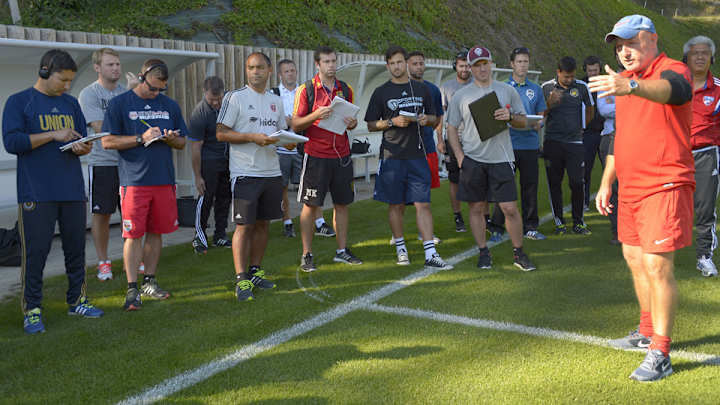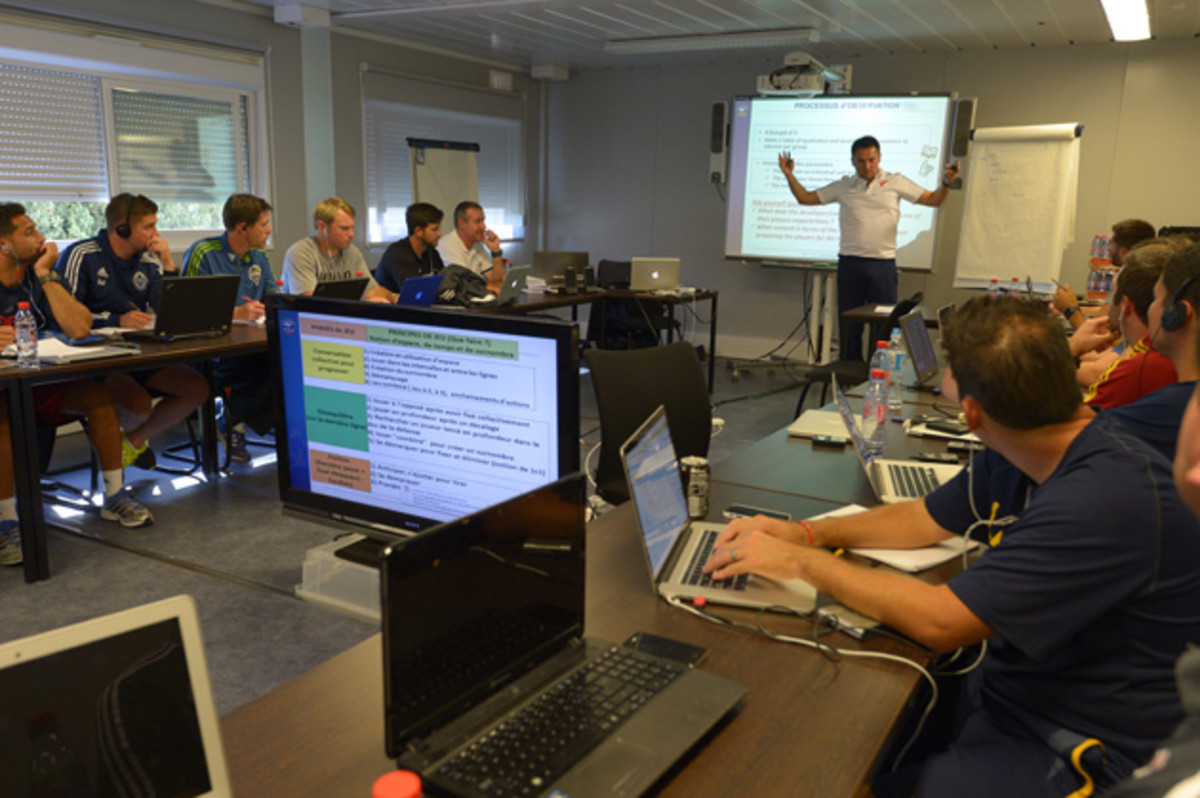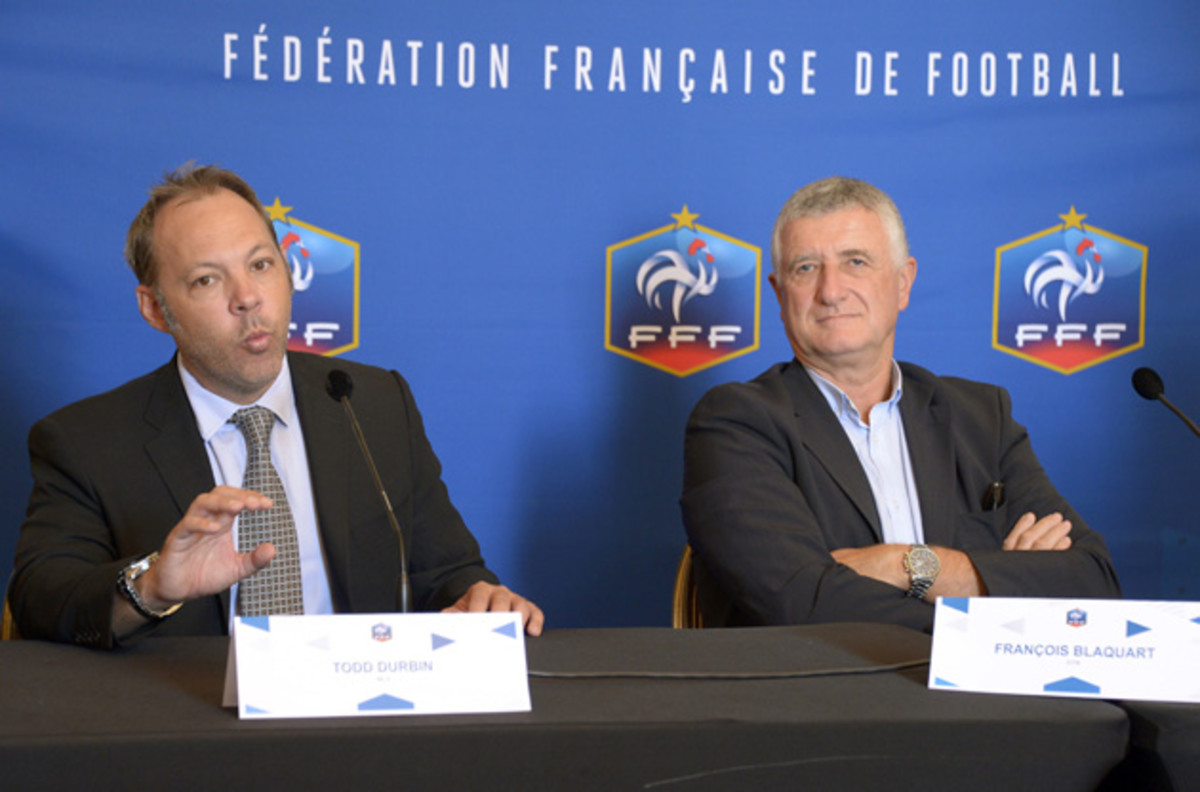How France is helping mold MLS academies, coaches

As 2016 shapes up to be a pivotal year in player and coaching development in the United States, Planet Fútbol dives into just what American clubs and the federation are doing in their quest to evolve as a soccer nation. This is the second of a three-part series on the subject. The first, on how audit firm Double PASS is bringing its methods to U.S. Soccer, can be read here.
As Major League Soccer enters its third decade of existence, league officials continually push youth development as the next big challenge to conquer. Every franchise runs its own fully funded academy at no cost to the players, but to continue raising standards within those academies, MLS entered into a partnership with the French Football Federation in 2013.
The agreement allows MLS academy directors and coaches to complete the Elite Formation Coaching License, administered by the French federation. In 2015, the second cycle of MLS coaches began the licensing process to earn the equivalent of a UEFA Pro License for youth coaches.
“Our owners have done a remarkable job in terms of their commitment and their investment in youth development, but one of the things that we were always thinking about was, how can we connect internationally?” MLS executive vice president Todd Durbin told SI.com. “How can we make sure that what we’re doing is on par or better than our international counterparts? By going through this program, it’s really allowed us to push our coaches to really benchmark themselves against the best development systems in the world.”
The MLS course resulted from a trip that Durbin took to France to get some ideas on how MLS could improve its development efforts. He met with French technical director François Blaquart in Paris, and the idea of the partnership came out of their discussions.
USMNT January Camp wrap: Winners, looking forward
The first cycle of the Formation License took two years and involved 320 hours of on-field and classroom instruction spread over eight weeks, two weeks of immersion at an academy in Europe and on-field work in the coach’s home environment. The second cycle has been scaled down to a one-year period, but the intensity remains the same, with coaches alternating weeks of instruction in France and the U.S.
“That course was the single hardest educational thing I’ve done in my life,” former Seattle Sounders academy director Darren Sawatzky said. “It was harder than my college degree.”
Many coaches passed the course, including Sawatzky, but several did not.
“You had five major projects, and your final major project that you had to deliver to them—Powerpoint, Prezi, whatever it was—mine was 46 pages long with embedded video and everything you can think of,” he said. “That course is really about pushing you to the point of what you’re capable of. You’d work 16-hour days and have to stay up until 1 in the morning doing Powerpoints that you’d have to deliver the next morning.”
Instructors expect complete mastery of the principles of play, but not just so candidates can explain the differences between playing 4-4-2 and 4-3-3. Instead, coaches are trained to pass the finer points of the game onto their players, which naturally means the coach must know the game inside and out.
“The first thing is, as an educator and somebody who needs to teach kids to play football, you yourself have to be a master of these principles,” said LA Galaxy academy coach Mike Muñoz, who is currently going through the course. “If you can’t recognize any of those moments [in the game], there’s no way you can teach your kids that. First and foremost, it’s becoming a master of the game. Then the next big piece that they try to get across is how to teach it. You’re the educator, and without telling the players the answers, how do you guide them?”

Self-reflection becomes a natural part of such an intensive and all-encompassing course.
“Essentially, from the first minute, it was the ability to know yourself and this idea that you can’t really do much until you know who you are,” said current Sounders academy director Marc Nicholls, who also passed the course and now mentors three candidates. “That idea of knowing yourself was something that, obviously, you don’t expect on a coaching course.”
As such, the technical and tactical aspects of the game are only a small part of the material covered. Participants are taught to think of themselves as teachers or instructors—not coaches. Much of the terminology used in the course comes out of the classroom rather than off the soccer field.
Candidates are schooled on the difference between pedagogy, or the theory and practice of education, and andragogy, the theory and practice of education in adults specifically.
“It was about your art and the delivery of your message,” Sawatzky said. “It’s maximizing the potential of a child. You don’t talk to an 11-year-old the way you talk to an 18-year-old, and the way you talk to an 11-year-old is now going to dictate whether they can bring information in for themselves.”
USA's Jerome Kiesewetter makes strong impression to start crucial year
In France, every head of a professional academy must hold an Elite Formation Coaching License. In April 2015, U.S. Soccer launched its first Academy Director License course after a pilot the previous year, but directors are not required to hold the license at this point. Both are comprehensive courses that cover every aspect of running an academy, but the French course has years of trial and error to its benefit.
“The idea is just to take over all the sporting issues of the academies of the MLS clubs,” French federation deputy director general Victoriano Melero said. “So I think the idea behind all this is to improve the training of young American players and, at the end, it will benefit of course the MLS but in particular, the national selection.”
Not that the first run of the French federation license with MLS coaches went perfectly. Translation of the material was notably difficult, eventually requiring FIFA translators who would be familiar with soccer terminology but also able to translate in real time, through the use of headsets like at the United Nations or a World Cup press conference.
Current candidates will convene again stateside in early spring, following their first week of instruction at France’s national training center, Clairefontaine, in September 2015 and a second week in Philadelphia two months later. Since then, candidates have also gone through their immersion experiences in Europe.
Around Europe: Torres hits 100, Serie A title clash beckons, more
In the first cycle of the course, Sawatzky visited Athletic Club Bilbao, where he ate breakfast with then-manager Marcelo Bielsa two mornings at his hotel, and Sporting Clube de Portugal.
“The reason I went to Bilbao and I was so excited about it was they only take players from the Basque region,” Sawatzky said. “You cannot have foreign players, which means if you don’t do a good job of development, you’re screwed.”
Nicholls visited Real Sociedad and Lyon, and Muñoz has been to Villarreal so far in the current cycle.
“I had complete access to the sessions, to staff meetings, to anything that you could imagine,” Muñoz said. “They were very friendly, very welcoming. No secrets, and it was good to see because their types of players are pretty similar to the types of players that we have in L.A., in Southern California. A lot of the exercises and sessions that they do were similar as well, and it was good to also kind of assess the talent based on the age groups compared to where we’re at.”
The next step is connecting the material from the Formation course to the coaches’ everyday work at home. As part of the first cycle of the partnership, MLS academies were encouraged to create or modify their current curriculum with the information they gleaned from the course.
French instructors were quick to praise the mentality of American players. Their motivation in training and willingness to listen to the coach—which Nicholls, an Englishman, also noted as a unique aspect of the U.S.’s general reverence for coaches—could be a strong base upon which to build better players.
“I don’t want to lose the American mentality. … We win all the time when we shouldn’t,” Sawatzky said. “Why would you want to train that out of kids? Keep that. You can still deliver the message and put an environment together where they can learn, but also learn to be winners.”
At the same time, Muñoz said his discussions with colleagues on the course since they began last fall have shown a shift in the training culture of MLS academies. As with the focus of the course, the changes are less explicit on game day and more obvious in the way coaches teach their players.
Late Altidore goal rescues wasteful U.S. in friendly win over Canada
“They have structured their week-to-week, their month-to-month, based off of these principles,” Muñoz said. “For example, Week 1 and Week 2, we’re working on possession for progression. So within that principle, they break down Monday through Thursday or Monday through Friday, different topics within that principle. So I would say [it’s] less about the games, more about the actual week-to-week and what goes into that.”
MLS also hired Frédéric Lipka, former Racing Club de France and Le Havre academy director, to serve as a liaison between the league and the French federation. His job description also includes guiding candidates as they attempt to finish their license and integrate it with their academy curriculum.
A handful of coaches who passed the course during the first cycle, including Nicholls, also returned to mentor the current group of candidates. Nicholls joined the new crop for one week of the course to deliver training sessions, and he speaks frequently with his three mentees as they progress toward their own licenses.
“Part of the course is in between sessions, the coaches have to complete 10 to 15 training blocks, so it’s looking over that with them, speaking to them about their training,” Nicholls said. “Sometimes, they’ll send video of their training. Helping them with the methodology, discussing ideas and then the other parts of their work, helping with that, in terms of other projects that they have to do for the course. Also, sometimes it’s just a case of just being a friendly voice and running ideas and them asking for clarity and discussing our experience.”

For the French federation, having a coach hired by MLS is one benefit that goes the other way in the partnership. Melero said the federation has enjoyed exchanging ideas with MLS and learning about the structure of the league.
The federation has also begun a program to place former French academy players at American colleges if they don’t sign professional contracts.
“It’s a real opportunity to go further in the U.S. soccer market and develop training programs not only dedicated to the MLS clubs but also to the university level,” Melero said. “So that will be our next challenge, and this is also of course an opportunity for us to have French people that are working for MLS clubs.”
In other words, the benefit of globalization and exchange of ideas that Durbin highlighted can go both directions. While the French federation gains a new perspective on the game, MLS and American soccer in general can learn how to build players of global quality from the youngest ages to push onto the first-team level.
“I think the take-on from it, one of the biggest, was that we can all change for the better in spite of this sort of machine that we’ve created here with tournaments and pay-to-play,” Nicholls said. “It can change, and I think it’s gradually starting to, so from a long-term perspective, it’s not just about this lovely certificate. It’s something that we can genuinely influence the game.”
Moving forward, MLS academies have to focus on finding the best players at younger ages and building them into professionals, while not losing sight of the community focus that many of the league’s franchises have taken on board.
In Seattle, for example, the Sounders want to bring players like DeAndre Yedlin and Jordan Morris through their academy from the newly created Under-12 age group through U-18 and to the first team, rather than taking them when they have almost aged out.
“We’ve identified players and taken them for a year or two, exposed them and helped them, but truly develop them?” Nicholls said. “That has to be our goal.”
